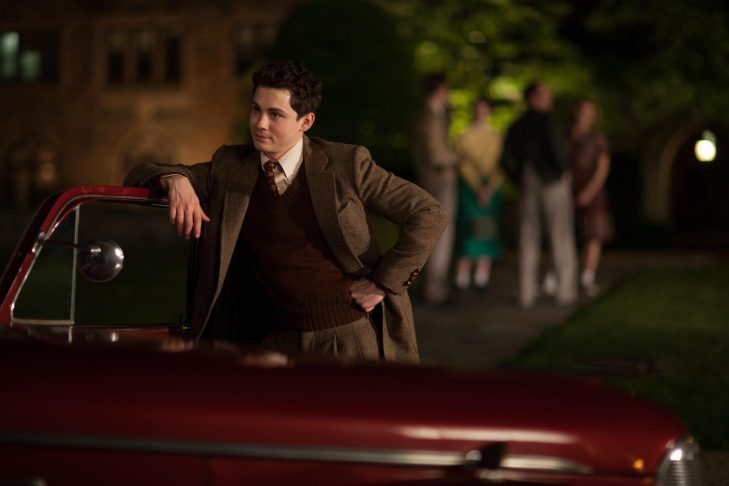James Schamus, the one-time CEO of Focus Features, has been responsible for the release of some of the best independent films of the past two decades. That list includes movies like “The Pianist,” “Brokeback Mountain” and “A Serious Man.” A prolific producer and writer, Schamus wrote the screenplay for “Indignation,” an elegant period piece based on the Philip Roth novel of the same name. The movie, however, stands out in Schamus’ oeuvre. Instead of delivering the screenplay to his long-time collaborator, director Ang Lee, Schamus opted to make Roth’s 29th novel his own directorial debut.
The film, which had its premiere at Sundance Film Festival in January and will run at West Newton Cinema beginning Friday, July 29, was screened in advance to a full house this past week at the theater. On hand to launch the film to Boston audiences was Schamus and the movie’s star, Logan Lerman. The two men participated in a Q&A moderated by Boston Jewish Film Festival executive director Jaymie Saks.
Published in 2008, the novel “Indignation” is one of Roth’s more personal works. The book is narrated posthumously by Marcus Messner, a Jewish teenager with straight As, which has enabled him to avoid the Korean War and attend Winesburg College in Ohio on a scholarship. Like Roth, Marcus grew up in Newark, N.J. And Marcus’ time at the Midwestern college echoes Roth’s own early 1950s college experience.
Schamus, who is Jewish, serendipitously happened upon the Roth novel in an airport bookstore and said he “fell in love with the characters. This is a late book for Roth. He knew he was retiring and wanted to go back to a time in his life before he was ‘Philip Roth.’” Schamus’ screenplay fittingly captures Marcus’ confusion and excitement at being in a world completely different from Newark and his father’s kosher butcher shop.
But at Winesburg he chafes at the school’s rules just as he balked at his parents’ overprotectiveness. Schamus makes clear from the beginning of the film that this is a time when many of Marcus’ childhood friends are dying in Korea. One of the film’s early scenes shows a man saying the Mourner’s Kaddish for his son and the Messners paying a condolence call to the family. Schamus noted that the scene was a nod to his favorite Allen Ginsberg poem, “Kaddish.” In researching the screenplay, Schamus said he was surprised when “I found out that Philip Roth was in the same generation as Allen Ginsberg. I don’t think of [Roth] in the same context.”
Schamus’ portrayal of Olivia, Marcus’ love interest, also calls up shades of another 1950s poet, Sylvia Plath. Olivia, a transfer student from Mount Holyoke College, bears the scars of a botched suicide on her wrist. “I read [Plath’s] journals in preparation for shooting,” said Schamus, “and three months before she died she was reading Roth. She wrote in her journals, ‘Someday I hope I write as well as Philip Roth.’”
The most jolting scene in the film is a fiery 15-minute sequence between Marcus and Dean Caudwell, who has called him into his office. Marcus’ Jewishness is as much on trial as his staunch atheism. He resents the college’s mandatory chapel attendance and cites Bertrand Russell’s attack on Christianity as the basis for his own rejection of religion.
The dean is played by veteran playwright and actor Tracy Letts, and Lerman holds his own throughout. Lerman told the West Newton audience that the scene was “risky” for him. “I hadn’t encountered a lot of material as complex and as challenging as [the “Indignation”] script,” he said. “I had a visceral reaction to reading it and knew I wanted to do it. Throughout shooting I was making discoveries and trying to find the most interesting versions of scenes and moments. That scene with the dean in particular had its own challenges. But I’ve never felt more fulfilled and creatively challenged as I was making this film.”
That pivotal scene—which spans 30 pages in the book—reflects the essence of the word “indignation.” “It’s a difficult word to contextualize for Americans who immediately translate it as angry,” said Schamus. “But it’s really about dignity and indignity and reclaiming your dignity. Roth is writing about a time in 1951 when America is going through another war, as well as experiencing xenophobia, McCarthyism and a backlash to the original feminism of Rosie the Riveter when women were independent and went to work during the Second World War.”
Despite Marcus’ ambivalence, Schamus’ screenplay doesn’t shy away from portraying Marcus’ Jewishness, nor does he sidestep the latent anti-Semitism at Winesburg. For his part, Lerman’s earnest and endearing portrayal of Marcus studiously avoids Jewish, Woody Allen-like stereotypes. “I didn’t notice the anti-Semitism at Winesburg. Speaking from my character’s perspective,” said Lerman, who is also Jewish, “he was frustrated about being categorized, and that isn’t necessarily anti-Semitic.” Schamus countered that “there were spectral prejudices working themselves through in the college, and anti-Semitism was part of the culture.”
Perhaps the two men’s varying perspectives reflected a generational difference. Schamus, who teaches film history and theory at Columbia University’s School of the Arts, said that when he screened the film in his classes, his African-American and foreign students identified with the film more than his Jewish students.
Schamus perfectly channels the conservatism of the 1950s and has a light touch with the novel’s devastating, final note. His film strikes a balance between culture and emotion, literary motifs and dramatic outcomes. And it captures a time when being a Jew was both curious and difficult.



